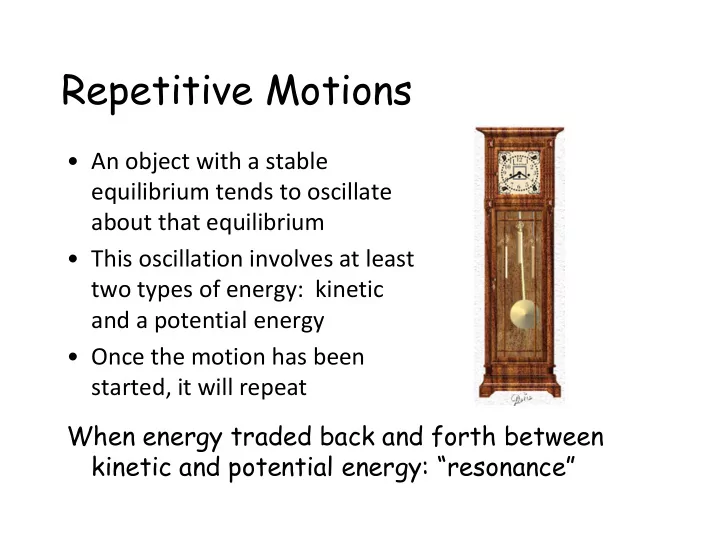

Repetitive Motions • An object with a stable equilibrium tends to oscillate about that equilibrium • This oscillation involves at least two types of energy: kinetic and a potential energy • Once the motion has been started, it will repeat When energy traded back and forth between kinetic and potential energy: “resonance”
Many objects in nature have natural resonances ! Resonance: energy can be stored in motion at a specific frequency Repetitive motion characterized by a: period (or frequency) and amplitude
Properties of oscillation Period: time of one full cycle Frequency (1/Period): cycles completed per second Amplitude: extent of repetitive motion In an ideal clock, the period (and frequency) should not depend on amplitude
The Harmonic Oscillator A special example of something with a natural resonance • Anything with a stable equilibrium and a restoring force (F) that’s proportional to the distortion away from equilibrium (x) (F = ‐ k x, where k is a constant) • Period is independent of amplitude • Examples: 1. Simple pendulum (small amplitude) 2. Mass on a spring
Every GPS satellite contains an atomic clock Receivers: high quality quartz clock which is synchronized to atomic clock
Sound is a wave! • Sound is a longitudinal pressure wave in a medium (gas, liquid or solid) • Anything that vibrates a medium produces sound • Air is the most common medium for carrying sound
•Waves have a wavelength: distance to next crest or trough •Waves have an amplitude: peak change in pressure for sound in air •Any mechanical wave “represents the natural motion of an extended object around stable equilibrium shape or situation”
The frequency, or pitch, of sound is the number of times per second that the wave repeats itself (or 1/period) wave speed = frequency × wavelength Watch one crest – moves at the speed of sound (330 m/s in air) Watch one place – the period is the time for the next crest or trough to appear
Producing Musical Sound Usually involves a resonator • An object’s natural vibration or resonant frequency is determined by its: – Mass – Size and shape – Elastic nature (stiffness) – Composition • Musical resonators – Stretched strings (violin string) Tacoma Narrows Bridge – – Hollow tubes (flute) a wind instrument! – Stretched membrane (drum)
Modes of Oscillation Fundamental Vibration (First Harmonic) – Center of string vibrates up and down – Frequency of vibration (pitch) is • proportional to tension • inversely proportional to length • inversely proportional to density (mass/length)
Modes of Oscillation • Higher ‐ Order Vibrations (Overtones or Harmonics) – Second harmonic is like two half ‐ strings – Third harmonic is like three third ‐ strings, … • Each higher mode has one more node in its oscillation • Harmonics come in integer multiples (1,2,3,4…) 2 nd Harmonic 3 rd Harmonic 4 th Harmonic Fundamental Wavelength = Transverse Standing Waves
Timbre Instruments have different musical fingerprint, or spectra Volume Frequency (Hz)
The Sound Box • Strings don’t project sound well – Air flows around objects • Surfaces project sound much better – Air can’t flow around surfaces easily – Movement of air is substantial!
Beautiful Music • Transfer of vibration to a “sound box” is important in instrument design – helps to project the sound effectively – helps to “color” the sound, making the instrument sound unique • The method of exciting the string also affects the sound. – Plucking a string transfers energy quickly and excites many vibrational modes – Bowing a string transfers energy slowly • excites the string at its fundamental frequency • each stroke adds to the string’s vibrational energy
Air Column as Resonant System • A column of air is a harmonic oscillator f 0 – Its mass gives it inertia 2f 0 – Pressure gives it a restoring force 3f 0 – It has a stable equilibrium – Restoring forces are proportional to displacement • Stiffness of restoring forces determined by – pressure – pressure gradient
Recommend
More recommend